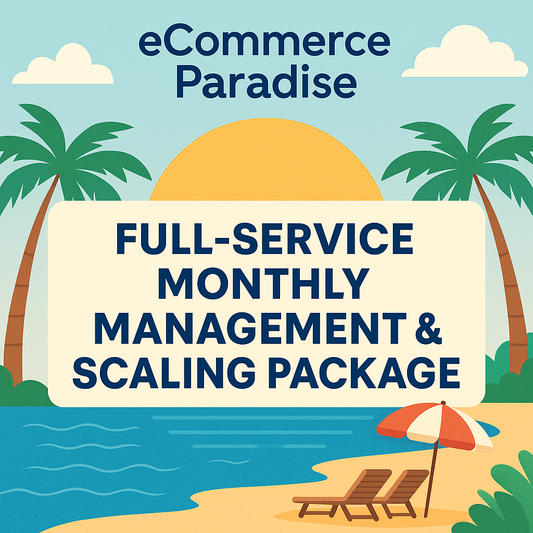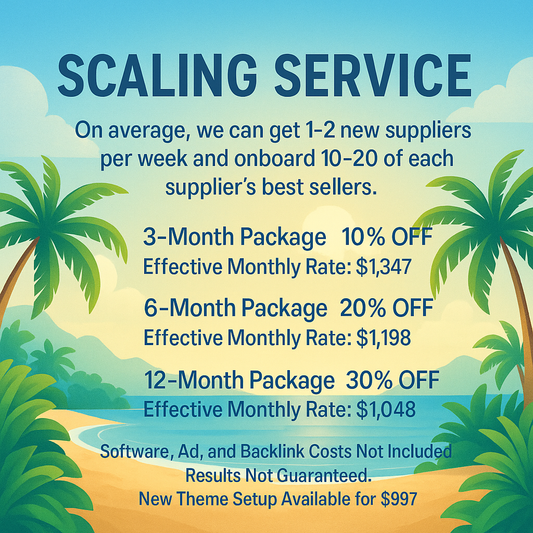
High-Quality Images: A Game Changer in Ecommerce SEO
Hey there, Ecommerce enthusiasts! Trevor Fenner here from Ecommerce Paradise, and today we’re diving deep into a crucial yet often overlooked aspect of online selling: the importance of high-quality images in ecommerce SEO. In an increasingly visual world, how your products are presented can make or break your success. Let’s break it down and see how quality imagery can elevate your business to new heights!
The Visual Appeal of Your Store
First impressions are everything in the online marketplace. A high-quality image not only showcases your product but also reflects your brand’s professionalism. Studies show that consumers are more likely to purchase from stores that have clear, captivating images. So, let's explore why high-quality images matter for your ecommerce store and how they intertwine with aspects of SEO, Google Shopping Ads, Email Marketing, and Dropshipping.
Why High-Quality Images Matter
When it comes to ecommerce SEO, imagery serves a critical role for several reasons:
- Enhances User Experience: High-quality images provide a better user experience. Customers can see what they’re buying, leading to informed purchasing decisions.
- Boosts Conversion Rates: Quality images can significantly increase conversion rates. When shoppers can see the details of a product, it inspires trust and encourages sales.
- Improves SEO: Optimized images lead to better search engine rankings. Google values user engagement and images that catch the eye can lead to longer site visits.
The SEO Connection
Let’s talk about how images fit into your overall ecommerce SEO strategy. High-quality images not only attract customers but also help in positioning your store higher in search engine results. Here's how to do it right:
Optimizing Images for SEO
There are a few key strategies you should implement to optimize your images:
- File Names: Use descriptive, keyword-rich filenames. Instead of “IMG_12345.jpg”, use “blue-vintage-chair.jpg” to give search engines relevant context.
- Alt Text: Alt text is essential for accessibility and can help with SEO. Describe the image specifically with keywords that relate to your product. For example, “A blue vintage chair perfect for eclectic decor” helps search engines understand what the image is about.
- File Size: Ensure images are not excessively large to maintain fast loading speeds. Use compression tools to keep file sizes low without sacrificing quality.
High-Quality Images and Google Shopping Ads
If you’re running Google Shopping Ads, quality imagery is invaluable. Google prioritizes ads with eye-catching images, making it critical to have high-quality visuals to stand out among competitors. When your potential customers search for products, they'll see a vast array of options, and striking images can compel them to click on your ad rather than someone else's.
Here are tips for using images effectively in Google Shopping Ads:
- Showcase Products In Use: Use lifestyle photos that depict your products in real-life scenarios. This helps potential customers visualize the item in their own lives.
- Consistency is Key: Maintain a consistent style across all your product images. This not only strengthens your brand identity but makes your ads more recognizable.
- Use Multiple Angles: Provide several images showing various angles and details of your product, allowing users to interact visually with what they’re purchasing.
Email Marketing & Image Quality
Email marketing remains a powerful tool for ecommerce stores, and images are often at the core of successful campaigns. High-quality images can boost your click-through rates and increase engagement. Let's see how you can effectively incorporate visual elements into your email marketing:
Strategies for Product Images in Emails
- Use Compelling Visuals: Always utilize high-resolution images in your emails. Avoid pixilated or cluttered images as they deter recipients from engaging with your content.
- Focus on CTAs: Pair images with clear, compelling calls-to-action (CTAs). For instance, if you’re promoting a new collection, ensure your images lead consumers to a seamless shopping experience.
- A/B Testing: Experiment with different image styles, placements, and sizes to see which ones yield the best engagement and higher conversion rates.
Dropshipping and Product Imagery
In the dropshipping world, where inventory management and fulfilling orders are handled by suppliers, presenting your products with high-quality images becomes even more significant. Since customers cannot physically touch or examine the products, your images must convey quality and clarity. Here’s how to do it effectively:
Optimizing Images for Dropshipping Stores
- Case by Case: Every product might need tailored photos. Don’t use generic images; consider requesting high-res images directly from suppliers or using stock images that align closely with the style of your brand.
- Set the Scene: Incorporating lifestyle imagery can differentiate your products from competitors. Showcase your items in various settings to appeal to your audience.
- Highlight Features: Use close-up shots to showcase quality and detail. This can be particularly important when selling items that can vary in style or finish.
Keeping Your Image Strategy Fresh
Just like fashion, the world of ecommerce has trends that come and go. Keeping your high-quality images fresh and updated is essential to reflect the current market. Here’s how to stay ahead:
- Seasonal Updates: Change your images with each season or special event. Capture the essence of holidays or seasonal shifts with updated lifestyle images.
- Collect User-Generated Content: Encourage satisfied customers to share their own images of your product. Not only do these images serve as authentic endorsements, but they also enhance your visual content!
- Invest in New Photography: If products change, invest in new, high-quality photo shoots to keep your site looking fresh and engaging.
Final Thoughts on Elevating Your Store
To wrap things up, high-quality images are not just a luxury; they are a necessity in the ecommerce landscape. They significantly impact your ecommerce SEO, help to attract and retain customers, and enhance the effectiveness of your marketing endeavors—not to mention their importance in Google Shopping Ads. As you focus on dropshipping products or sending out compelling email marketing campaigns, remember that each image you use is a reflection of your brand.
So get to work on boosting your visual appeal! Your sales will thank you, and you'll create an engaging, memorable shopping experience that resonates with customers for years to come. Cheers to your ecommerce success, and happy selling!


















